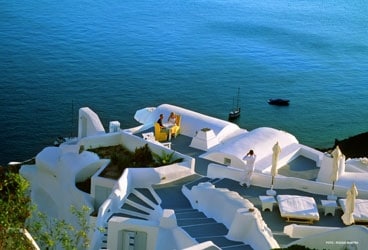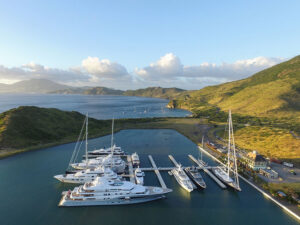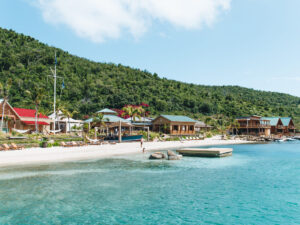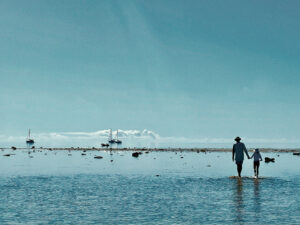
ChildressGreece368
If you ask people to conjure up their image of the Greek islands, they inevitably describe one that closely matches the photograph perpetrated on travel posters and in advertisements worldwide–the deep-blue church dome on the island of Santorini, framed against the backdrop of a sapphire sea. Indeed, the Cyclades islands, of which Santorini is one, are the most popular vacation destination of all the island groups, but there are other island groups and coastal destinations, less promoted and therefore often overlooked, that offer a diverse and equally enchanting travel experience. Here, we’ll take a thumbnail look at the Cyclades, other top island groups in which to charter, and what each has to offer.
The Cyclades
These islands are the hands-down first choice among charterers. Situated in the center of the Aegean, the islands get their collective name from the Greek word kyklos, meaning “ring” or “circle,” because the islands form a circle around Delos island, the now-abandoned ancient city (sometimes compared to Pompeii) that was the region’s ancient center of commerce and religion. In summer, the islands are arid and somewhat barren. Quintessentially Greek, bright-white stucco buildings perch on hillsides like scattered sugar cubes beneath cerulean skies, and the landscape is sprinkled with windmills.
The choices for the charterer who chooses the Cyclades are diverse: from the bustling waterfront towns and nightlife on Mikonos, Paros, and Íos to the vistas of Santorini to the tranquility and peace of smaller islands such as Folegandros and Amorgos. The islands are known for their multitude of excellent beaches, though the water here tends to be cooler than in other island groups. History buffs won’t be disappointed either: Delos is one of the most wondrous archaeological sites in the world. This deserted city has a magic about it that’s palpable. On Paros island, the 5th-century Church of 100 Doors and the Archaeology Museum are star attractions; and on neighboring Antiparos “The Cave” is a natural wonder that looks like a Disney creation, and is said to have famous visitors’ names carved on the walls, including Lord Byron’s.
For those arriving by boat, there are several considerations. First is time frame. The first of the Cyclades islands, Kea, is 45 miles from Athens, the port from which most chartered boats depart. Especially for those on sailboats, the distances between islands here should be considered: The Cyclades are farther apart than those in other island groups, leaving less time for sightseeing ashore and requiring more time under way, with less time for lunch and swimming stops. The second consideration is wind. Because the islands are in the Aegean’s center, they lie unprotected by the mountainous mainland, and when the meltemi (strong, seasonal north wind of Force 5 to 6, sometimes as high as Force 8 or 9) kicks up, it can mean rough weather at best, or lost sailing days due to port-authority-imposed sailing bans at worst. The meltemi is at its peak in July and August, though it can blow sporadically in late June and early September.
The Cyclades are Everyman’s dream of the Greek islands, and with their number and diversity, there’s something here to realize anyone’s dream.
The Saronics
Due to their proximity to Athens, these islands were one of Greece’s first island-vacation spots, and today they remain popular among locals and visitors alike. More lush and green than the Cyclades, the islands also have the advantage of being protected by the mainland; sailing conditions even in strong winds are generally calmer because seas don’t build to the extent that they do in the unprotected Cyclades.
Sea temperatures are generally warmer than in the Cyclades, and though the beaches don’t rival those in the Cyclades, there are plenty of excellent places to swim.
With a short time frame, these islands are an excellent choice. Highlights of a Saronics cruise generally include bustling Poros, the closest of all the Greek islands to the mainland, separated from it only by a picturesque, narrow channel offering views of the island on one side and the craggy, green mountains of the Peloponnesus on the other; and Hydra, steeped in history and one of the most beautiful harbors in Greece, lined by the homes built by sea captains in the 18th century. Often called the “St. Tropez of Greece,” Hydra attracts its share of the rich and famous along with hordes of tourists arriving by day boat, but the cobbled streets, donkeys (donkeys are used for all kinds of transport, as there are no cars on the island), and whitewashed bougainvillea-draped walkways up away from the harbor make it the favorite of most who choose a Saronics cruise. Spetsai, not far away, has its own upscale charm, and though there are cars on the island, horses and buggies still clack along the waterfront streets. Aigina, Greece’s first capital and the island where the first Greek coin was minted in 650 B.C, is the site of the Doric Temple of Aphaia. This shrine, built for the goddess of wisdom and light, is one of the most well-preserved ruins on any Greek island.
A Saronics cruise often also includes stops on the Peloponnesus west coast and mainland and the tiny villages of Ermioni and Leonidhion; or perhaps the beautiful city of Navplion, the second capital of Greece, and one of its most picturesque sites, crowned by the towering Palamidi Fort. With more time, it’s possible to include on this itinerary the hamlet of Yerakas-a village nestled between mountains and entered via Greece’s only fjord, and Monemvasia, the restored Byzantine town perched on a peak that’s often called “The Gibraltar of the Aegean,” little known to foreign tourists but possibly rivaling Santorini for its vistas and romance.
The Ionian
These islands, stretching along the west-northwest coast of the Peloponnesus and the Greek mainland, lie 200 miles from Athens and are known as “the Caribbean of Greece,” and with good reason. Lush, green islands rise out of an aquamarine sea, and the architecture has a Venetian influence, with red-tile-roofed homes, and buildings painted in a colorful array of pastel hues. Good beaches abound; water and air temperatures are milder than in other islands, and winds are generally lighter. Snorkeling here is some of the best in Greece.
The Ionian is home to the famous island of Ithaka, allegedly the isle of real-or-mythical Odysseus; Corfu, which has been described as “a luxuriant Garden of Eden,” and has inspired writers such as Shakespeare (it’s said to be the magical island in The Tempest), and brothers Lawrence and Gerald Durrell, in Prospero’s Cell, and My Family and Other Animals, respectively.
For charterers leaving from Athens, reaching these islands requires a transit of the Corinth Canal, which is in itself worth seeing. From Athens, 10 days’ minimum in the Ionian is a must; the alternative is to fly to the islands, most probably to Lefkada, and join the boat there for a more relaxed exploration of these lovely islands.
The Dodecanese
So named because there are 12 of them-dodeka means twelve in Greek-this island chain stretches along the east coast of Turkey in the eastern Aegean, and lies 250 miles from Athens. From Patmos in the north to Rhodes in the south, charterers will find not only distinctive scenery and architecture, but plenty of other attractions, including the site where St. John is said to have written The Apocalypse on Patmos; the slumbering volcano on Nissiros, the Knights of the Castle of St. John, the Temple of Hera, and the fortified artists’ colony and archaeological site of Lindos, on Rhodes; and the ancient shrine to the healing god Asklepeios and Hippocrates’ plane tree on Kos, to name a few. From piney forests in the north to palm trees in the south, the atmosphere is as varied as the terrain. Classic white stucco on some islands contrasts with Venetian-and-Turkish influenced architecture on others; and there are bustling hubs with plenty of shopping and nightlife as well as secluded anchorages with beautiful beaches.
Charterers wishing to cruise here should consider meeting the boat in one of the northernmost Dodecanese islands such as Patmos and working south, perhaps ending the cruise at Rhodes, which is a good option. The islands, like the Saronics, are protected by the Turkish mainland. Winds are generally steady but not overpowering, and the climate is mild.
Whatever island group charterers choose, the best approach to a Greek Islands charter is to set a loose itinerary and keep an open mind. Good charter crews know the islands inside and out, and they’ll likely be able to suggest spectacular places not found or featured in any guidebook. While charterers may not have 10 years to roam the seas, as did Odysseus, the credo “let the winds take us where they may” is an excellent one to follow when sailing these spectacular islands.
Lynda Morris Childress is a CW contributing editor based in Greece.








